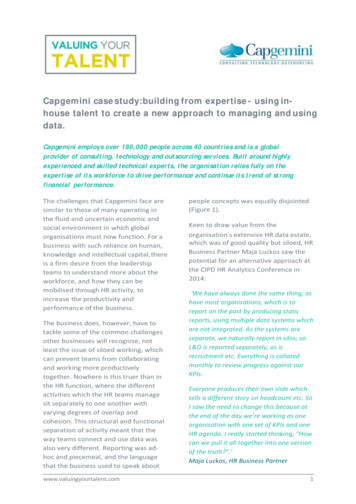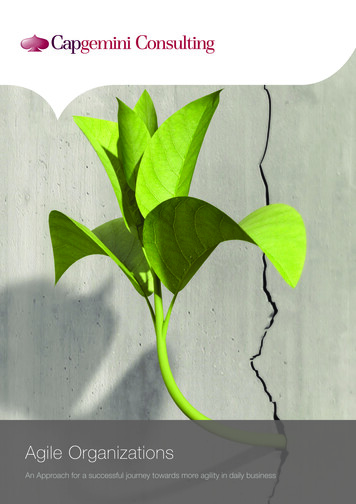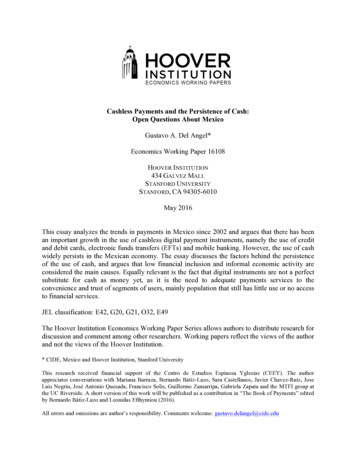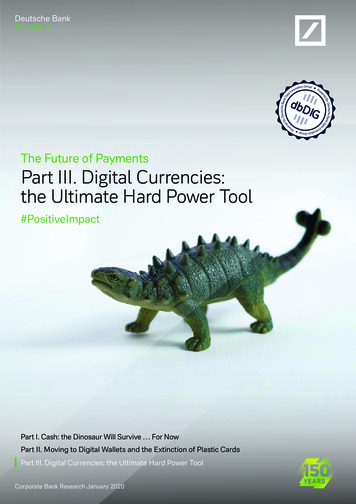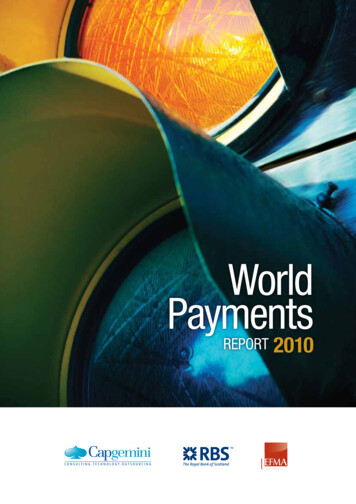
Transcription
WorldPaymentsREPORT2010
TABLE OF CONTENTS3Preface4Summary of Key FindingsSection 1: World Non-Cash Payments Markets and Trends7Highlights8Non-Cash Payments Maintain Healthy Growth16Alternative Payment Service Providers20PayPalSection 2: Payments-Related Regulatory Update23Highlights24SEPA and PSD Implementation Progress30Increasing Financial System RegulationSection 3: The Transformation of the PaymentsValue Chain Is Accelerating34Highlights35Introduction36How the Payments Industry Is Evolving40In the Fast-Shifting Landscape, Banks Need to Decide toWhat Extent Payments Are Core to Their Strategies43Partnerships and Sourcing Are Both Enabling Strategies45Is Payments Outsourcing Just a Matter of Time?46Full Payments Outsourcing47The Payments Hub: Achieving More with Less50Rationalising the Product Portfolio before Embarkingon a Hub Implementation52Conclusion53What Lies Ahead54Methodology56Glossary
PrefaceNow in its sixth year, the World Payments Report from Capgemini, The Royal Bank of Scotland (RBS),and the European financial marketing association (Efma) looks at the payments business as it faceschallenges from economic and competitive conditions, technology advances, increased regulatorypressure and customer demands.Payments and other transaction banking services proved resilient during the economic crisis, but therapidly changing external environment will require banks to decide to what extent payments are core totheir business strategies.The World Payments Report 2010 looks at global trends in payments volumes, describes progress inimportant payments-related initiatives, such as the Single Euro Payments Area (SEPA) and thePayment Services Directive (PSD), and looks at how new regulations are creating additional pressure onthe payments landscape.We include an overview on the Basel III framework, which will require strong management attention,and we spotlight its more stringent liquidity requirements, as they will increase costs and could requirerepositioning for some banks.We explore how new technologies and competition are making the payments universe more complexand expansive and why, as a consequence, banks will need to dedicate more strategic attention to theirpayments value propositions.We describe how banks will need to consider their options carefully for optimising their paymentsbusinesses, as the transformation of the payments value chain is accelerating.We then focus on how banks will need to employ an intense parallel strategy, comprising revenuefocussed and cost-focussed initiatives, leverage sourcing strategies and consider mechanisms such asPayments Hubs to make these parallel strategies feasible and allow banks to achieve more with less.We hope this year’s report provides useful insights.Bertrand LavayssièreManaging DirectorGlobal Financial ServicesBrian StevensonChief ExecutiveGlobal Transaction ServicesCapgeminiThe Royal Bank of ScotlandPatrick DesmarèsSecretary GeneralEuropean financialmarketing association3
Summary of Key FindingsBanks are used to ongoing shifts in the payments landscape, but a wave of newchallenges, driven by economic and competitive conditions, technologyadvances, regulatory pressure and customer requirements, is accelerating thetransformation of the payments value chain, and banks will need to decide howbest to respond. The World Payments Report 2010 looks at the trends inpayments volumes and instruments usage, key payments-related regulatoryinitiatives, and the consequent strategic challenges and options for banks.The key findings of this report include the following:The payments business has withstood the financial crisis well. Only timewill tell the ultimate impact, but initial data suggest payments volumescontinued to expand in 2009: The global use of non-cash payment instruments continued to grow in2008, despite the financial crisis. The overall growth in volumes acceleratedto 9% in 2008 from 7% in 2007, and preliminary data suggest paymentscontinued to grow in 2009. Volumes in 2008 grew only modestly in developedmarkets and registered the largest increase in certain developing economiessuch as China (up 29%), South Africa (up 25%) and Russia (up 66%). Globally, cards remain the preferred non-cash payment instrument,accounting for more than 40% of payments in most markets and above58% globally. Initial data show that card transaction volumes continuedto grow in 2009. Alternative payment service providers (PSPs) have made significantstrides in m-payments and e-payments, even though they still account fora small percentage of total worldwide transaction volumes. Cash-in-circulation in the Eurozone maintained a steady growth of about11% per year since 2002, representing a significant cost for globaleconomies (the European Payments Council estimates that the cost of cashpayments for European Union economies is 50 billion to 75 billion a year).4
Summary of Key FindingsSeveral developments have taken place in the last year towards SEPA and PSD in Europe: Nearly all European Economic Area (EEA) Member States had transposed the Payment ServicesDirective (PSD) into national law by August 2010. However, certain inconsistencies in interpretation stillremain, and these ambiguities will need to be resolved to help ensure SEPA can progress as planned. Banks are compliant with SEPA Credit Transfers (SCTs), but volumes remain low. SEPA Direct Debit(SDD) was launched as planned in November 2009 for both consumers (SDD Core) and corporates(SDD B2B) and even if the reachability rate is high (70%), usage at this stage is still very low. RegardingSEPA for cards, the vision of “any card at any terminal” is still far from a reality. However, Europeancard initiatives (EAPS, Monnet and PayFair), designed to rival the established duopoly of Visa andMasterCard, have each made progress. Nearly all stakeholders now agree that full SEPA migration will lag unless forced by regulation.In June 2010, the European Commission (EC) announced that self-regulatory efforts were not sufficienton their own to drive concerted migration to SEPA and it was intending to draft binding legislation onmigration end dates.Regulatory pressures continue to affect the payments industry worldwide: Industry-wide global regulations are expanding in response to the crisis, creating intense pressure on theindustry. Implementing the Basel III framework, in particular, will require management attention andinvestment. The more stringent liquidity requirements will increase costs and could require strategicrepositioning for banks. Anti-Money Laundering (AML) and Anti-Terrorist Financing (ATF) requirements are likely to increasethe costs of processing payment orders, reducing efficiency and slowing the rate of straight-throughprocessing (STP).New technology and competition are making the payments universe more complex and expansive and,together with the effects of the economic crisis, new regulatory initiatives are acting as catalysts tothe further evolution of the industry: New entrants, enabled by customer-friendly regulations and fast-emerging technologies, are gainingground in the more open Business to Business (B2B), Business to Consumer (B2C) and Consumer toConsumer (C2C) payments spaces. In recent years, the payments industry has seen many new entrants,and many of them offer state-of-the-art, highly honed and comprehensive value propositions for certain clients.The traditional payments value chain is transforming as players adapt themselves to the new landscape. The transformation of the value chain will accelerate. Client-facing and processing segments of thevalue chain will transform more rapidly. The first will be mainly affected by competition from new entrantsand the programmes banks will dedicate to access client value chains, alone or with partners; the second willbe affected by the insourcing/outsourcing solutions adopted and other improvements of the operating model. Sourcing strategies will increasingly play a decisive role in banking strategies. Revenue-focussedinitiatives will require skills, expertise in partnerships and an ability to measure results. Cost-focussedinitiatives will be possible mainly through outsourcing or insourcing volumes to reduce costs or achieve scale. Payments Hubs can allow banks to achieve more with less. Effectively designed processes andarchitectures will allow a bank dedicated to the payments business to execute both revenue- and costfocussed initiatives in parallel, and will strengthen product innovation and operational excellence.World Payments Report 20105
6
section title l1section titlE l2World Non-Cash PaymentsMarkets and TrendsHIGHLIGHTS The global use of non-cash payment instruments (direct debits, credittransfers, cards and cheques) continued to grow in 2008, despite thefinancial crisis. The growth in volumes accelerated to 9% in 2008 from 7% in2007. Global transaction volumes totalled 269 billion in 2008, after sustainedaverage growth of 8.4% a year since 2001—growth that has outpaced theexpansion in global gross domestic product (GDP). The largest increase in non-cash payments volumes was found in certaindeveloping economies, such as China (up 29%), South Africa (up 25%) andRussia (up 66%), in which economic activity was relatively more robust.Volumes grew modestly in developed markets, but the outright totals in NorthAmerica and the mature economies of Europe and Asia still overshadowed those inemerging markets, and accounted for 77% of global volumes in 2008. Globally, cards (credit and debit) remain the preferred means of non-cashpayment, accounting for more than 40% of payments in most markets andabove 58% globally. Globally, card-transaction volumes were up 15% in 2008,and their value was up 6.6%. Many European countries saw a drop in the averagevalue per card transaction, in line with past trends, suggesting many individuals areincreasingly using non-cash means even for low-value transactions. The payments business has withstood the financial crisis well. Only timewill tell the ultimate impact, but initial data suggest payments volumescontinued to expand in 2009. World exports were certainly hit by the crisis,though data have yet to show the exact impact on demand for trade finance.The crisis is also thought to be undermining growth in workers’ remittances,which have clearly slowed since the last quarter of 2008 and are expected toshow an outright decline in 2010. Since 2002, cash-in-circulation in the Eurozone has grown about 11% peryear. The war on cash is still far from won and the continuing expansion of cashand the high associated expenses (use of cash costs EU economies an estimated 50 billion to 75 billion a year) should encourage additional efforts by allstakeholders to reduce the use of cash for payments. Non-bank payment service providers (PSPs) have made significant strides ine-payments and m-payments even in developed markets, where banks have along-standing relationship with both consumers and merchants. But non-bankPSPs still account for a small percentage (0.6%) of total worldwide non-cashtransaction volumes.World Payments Report 20107
Chapter 1Non-Cash Payments Maintain Healthy GrowthGLOBAL USE OF NON-CASH PAYMENTS GREWAGAIN IN 2008, DESPITE THE CRISISThe growth in global non-cash payments volumesaccelerated to 9% in 2008 from 7% in 2007, despitethe continued financial crisis. Volumes totalled 269billion in 2008 (see Figure 1.1), after sustainedgrowth of 8.4% a year since 2001—growth that hasfar outpaced the expansion in global GDP.The outright volume of non-cash payments remainedheavily concentrated in developed markets. In fact,while volumes grew only modestly (5–6%) in NorthAmerica and the mature economies of Europe andAsia-Pacific,1 those segments still accounted for acombined 77% of non-cash payments volumes in2008. The top ten 2 payments markets accounted for91% of all global volumes in 2008.Still, the rate of growth in non-cash payments volumeswas faster in developing economies, especially theBRIC (Brazil, Russia, India, China) nations, in whicheconomic activity remained robust relative to moredeveloped nations. For example, the year-on-yeargrowth in transaction volumes was particularly strong(29%) in China in 2008. Emerging markets also havefar more limited banking infrastructures thandeveloped markets, and these constraints are spawninga significant number of payments innovations, whichshould be an important source of growth in paymentsvolumes in the years ahead.8Behind the aggregate increase in 2008 non-cashpayments volumes, there were notable trends in themix and use of individual instruments (see Figure 1.2for 2001 vs. 2008 payments mix). Those trendsincluded the following: Cards (credit and debit) remained the preferredmeans of non-cash payments globally, accountingfor more than 40% of non-cash volumes in mostmarkets and above 58% globally. Globally, cardtransaction volumes were up 15% from 2007, andtheir value was up 6.6%. Globally both debit and credit card volumes rose ata similar pace although regional differences wereapparent. Credit-transfer volumes rose 7%. Direct debits,which also showed a 7% volume increase, areespecially gaining popularity in Europe and the U.S. Cheque volumes continued to decline (by 6%),largely reflecting the increasing popularity ofonline bill payment and efforts by banks andgovernments to reduce usage.1North America comprises Canada and the U.S.; mature Europe includes the entire Eurozone; and mature Asia-Pacific comprises Australia,Japan, Singapore and South Korea2The top ten non-cash payments markets, in order of size, are the U.S., Eurozone, China, the U.K., Canada, Brazil, South Korea, Japan, Russiaand Australia
Section 1Non-cash Payments Maintain Healthy GrowthFigureof sactionsRegion(Billions),20012008FIGURE1.11.1. NumberNumber Cash Transactions (Billions)250C
Now in its sixth year, the World Payments Report from Capgemini, The Royal Bank of Scotland (RBS), and the European financial marketing association (Efma) looks at the payments business as it faces challenges from economic and competitive conditions, technology advances, increased regulatory pressure and customer demands.
